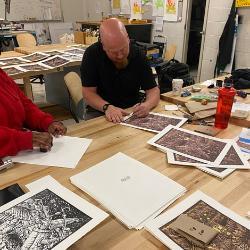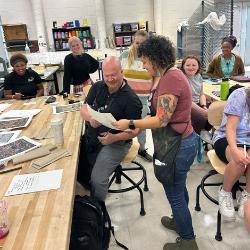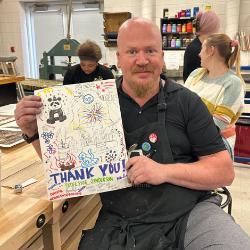
One of the most valuable rewards of producing art is sharing it with other people. Meghan O’Connor, assistant professor of printmaking in the Department of Visual Arts, operates on this principle and embeds it into her professional and creative work. As a result of her efforts, Edwards College visual arts students and faculty recently had the benefit of working and learning from visiting artist Brandon Sanderson.
 Sanderson, who works in printmaking and drawing, is a professor, head of printmaking, and director of the Pembroke Undergraduate Research and Creativity Center at UNC-Pembroke. This semester, he shared his expertise with CCU students, faculty and community in a number of ways. Sanderson’s exhibit The Denizens has been on display in the Cube Galleries – a series of satellite, mini-galleries located around the CCU campus – throughout the month (Oct. 2- Nov. 3), and Sanderson visited campus Oct. 10-12 for a lecture, series of workshops with visual arts students, and personal production period.
Sanderson, who works in printmaking and drawing, is a professor, head of printmaking, and director of the Pembroke Undergraduate Research and Creativity Center at UNC-Pembroke. This semester, he shared his expertise with CCU students, faculty and community in a number of ways. Sanderson’s exhibit The Denizens has been on display in the Cube Galleries – a series of satellite, mini-galleries located around the CCU campus – throughout the month (Oct. 2- Nov. 3), and Sanderson visited campus Oct. 10-12 for a lecture, series of workshops with visual arts students, and personal production period.
The Denizens is a series of oddly eccentric characters comprised of both organic and mechanical elements. The awkward beings imply an antisocial ethos, yet they live together in a community and convey a sense of nontraditional belonging. Sanderson said the inspiration for the series came from the experience of living through Covid as a person with a disability. Sanderson lives with severe hearing loss.
“I hear half of what a normal person does,” said Sanderson, “and my work is about coming to terms with that and the struggles somebody with a disability has. I started making this body of work because as a professor during Covid – as someone who reads lips – there was no accommodation for my disability. However, when you look at the work, I don’t expect people to know that. I want them to come up with their own stories. That’s what the work is about at its core.”
Sanderson and O’Connor have a professional relationship that spans nearly two decades, and it’s representative of the kind of networking they both believe is important in a visual arts education. They met at the renowned Frogman’s workshop, which then took place at the University of South Dakota, when O’Connor was in graduate school at Clemson University.
“It was an experience where I made a lot of friends but also formed professional relationships with people,” said O’Connor. “Since then, we’ve supported each other and created projects together – exhibitions or presentations at conferences or symposia. We also take the things that we’ve done, the things we’ve learned, and share them with students at our home institutions.”
together – exhibitions or presentations at conferences or symposia. We also take the things that we’ve done, the things we’ve learned, and share them with students at our home institutions.”
Throughout the years, Sanderson and O’Connor have collaborated at various workshops and programs, and O’Connor has worked as visiting artist at UNC-Pembroke multiple times.
“If you have somebody you work well with and is reliable, then it can be an ongoing relationship,” said Sanderson.
 In addition to his recent Cube Gallery exhibition, Sanderson shared his expertise with CCU students and community through a public lecture and a three-day workshop series that allowed him, with students alongside,to produce 7 prints that involved single color relief blocks, and a combination of woodcut and screenprinting. He donated a portion of his work to Claw and Feather press, a CCU-based printing press that produces original works for retail sale to fund student scholarships, research, and visiting artist opportunities.
In addition to his recent Cube Gallery exhibition, Sanderson shared his expertise with CCU students and community through a public lecture and a three-day workshop series that allowed him, with students alongside,to produce 7 prints that involved single color relief blocks, and a combination of woodcut and screenprinting. He donated a portion of his work to Claw and Feather press, a CCU-based printing press that produces original works for retail sale to fund student scholarships, research, and visiting artist opportunities.
Both Sanderson and O’Connor commented on the importance of visiting artists on an undergraduate’s education.
“These are high-impact learning experiences,” said O’Connor. “It’s a completely different relationship when you’re working in an apprentice-style manner. There’s a lot more one-on-one opportunities with the artist, and they bring in different perspectives.”
Sanderson agrees.
“The point of visiting artist programs is to break up students’ ordinary class schedule and allow them the opportunity to work with somebody new,” said Sanderson. “Students really need to take advantage of that. If I hadn’t done such things when I was a student, I would have missed out on a number of job opportunities and residencies.”
O’Connor, who also recently served as a judge at a Waccamaw Artist’s Guild juried show, added that art has unlimited potential as a means to enhance interpersonal relationships.
“My passion really lies in community and getting people connected to each other using teaching, art, and workshops,” said O’Connor. “Because that’s what it’s all about. Connecting with each other.”





